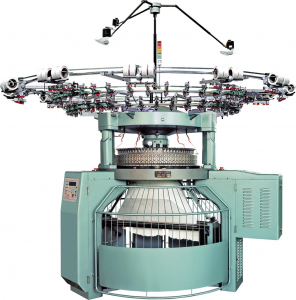The circular knitting machine of normal production will leave a trace in the weft direction of the woven fabric after it is stopped and restarted. This kind of mark varies depending on the type of fabric, the condition of the loom and other factors. Generally, there will be a sunken fine mark, which is obvious from the fabric woven before and after the loom stops; sometimes there will be wider marks, which are different from the loom The difference between the woven fabrics before and after the shutdown is not very obvious. After the fabric is dyed, there will be a certain color difference between the position of the stop mark and the normal production of the non-stop fabric. If the stop mark occurs frequently and the degree is relatively serious, it will affect the normal cutting and use of the fabric and cause waste.
Causes of stop marks
There are many reasons for the stop marks: the sudden change in the amount of yarn feeding causes uneven yarn tension, thereby changing the shape and size of the coil to form stop marks; 1. The positioning pin of the transmission shaft is worn out. In severe cases, the gear shaft center will also be worn and enlarged, which will affect the yarn tension and cause stop marks; The wear of the transmission belt of the grain and the yarn storage device, or the insufficient pressure between the transmission belt and the colloidal grains, and the sudden change in the running speed of the loom during the shutdown and start-up process will cause the friction coefficient between the colloidal grains and the conveyor belt to become smaller, forming a relative slip, causing the unit The change of the number of turns and the amount of yarn feeding will affect the tension of the yarn and form the stop mark.
The wear of the transmission teeth of the yarn storage device or the stuffing of lint, and the wear of the conveyor belt of the yarn storage device will make the relative sliding between the yarn storage device and the conveyor belt intensify during the shutdown and start-up of the loom, resulting in a reduction or increase in the amount of yarn feeding per unit number of turns. , forming stop marks. In this case, the stop mark is wider, which is also caused by the change of the length of the coil, and the length of the coil generally changes by 2% to 8%. The looseness and wear of other related transmission belts in the yarn feeding system will also cause uneven tension and stop marks during shutdown and startup.
Ways to Improve Shutdown Marks
Generally speaking, the methods to improve the stop marks mainly include prolonging the deceleration time of the loom, increasing the blanking force, reducing the empty position of the rising rod of the triangular chassis, and the selection of the machine type.
The longer the deceleration process of the loom, the smaller the swing change rate between the gears and the relative slip change rate of the transmission belt, so that the tension of the yarn will not change too quickly, thereby reducing the degree of stop marks. The longer the braking time, the longer the loom will continue to run after the yarn breaks. Due to the limitation of the yarn storage capacity of the yarn storage device, it is generally advisable to set the braking time as 1.5 seconds to 1.8 seconds, so as to ensure that the yarn will not cause rotten cloth after the yarn breaks .
Improving stop marks can also be achieved by reducing triangular chassis rise bars
virtual realization of . That is to reduce the meshing gap between the gears and the relative swing between the gear and the shaft, and reduce the virtual position between the needles and the triangle (leaf bed virtual position). In order to ensure the normal operation of the loom, the empty position of the leaf bed can generally be controlled at about 0.1 mm.
At present, the triangular base of most models of needle cylinders adopts a central lifting device, and the support rods at each rising point have a large vacant position, so that when the knitting needle rotates rapidly, it drives the triangular seat upwards to cause tension changes. Appropriately reducing the virtual position of the support rod can not only ensure the normal use of the central lift but also prevent the triangular seat from being thrown too seriously. When the loom is running normally, the throwing amount of the triangular base plate is generally controlled within 0.03 mm.
Most circular knitting machines now use wear-resistant sheets to replace the design of the wire runway. After 3 to 5 years of normal use of the circular knitting machine with steel wire runway wave beads, due to the wear of the wave beads and the steel wire runway, when the loom is accelerating and decelerating, the needle cylinder drifts seriously, which increases the severity of the stop marks. Therefore, when choosing a model, the manufacturer should try to avoid choosing enough models of this type, and should choose a model with good precision and perfect design.
Post time: May-11-2023






